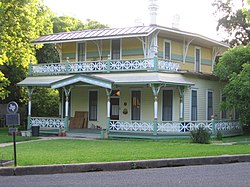
The Fan is a district of Richmond, Virginia, so named because of the "fan" shape of the array of streets that extend west from Belvidere Street, on the eastern edge of Monroe Park, westward to Arthur Ashe Boulevard. However, the streets rapidly resemble a grid after they go through what is now Virginia Commonwealth University. The Fan is one of the easterly points of the city's West End section, and is bordered to the north by Broad Street and to the south by VA 195, although the Fan District Association considers the southern border to be the properties abutting the south side of Main Street. The western side is sometimes called the Upper Fan and the eastern side the Lower Fan, though confusingly the Uptown district is located near VCU in the Lower Fan. Many cafes and locally owned restaurants are located here, as well as historic Monument Avenue, a boulevard formerly featuring statuary of the Civil War's Confederate president and generals. The only current statue is a more modern one of tennis icon Arthur Ashe. Development of the Fan district was strongly influenced by the City Beautiful movement of the late 19th century.

Inman Park is an intown neighborhood on the east side of Atlanta, Georgia, and its first planned suburb. It was named for Samuel M. Inman.

Hyde Park is a neighborhood and historic district in Austin, Texas. Located in Central Austin, Hyde Park is defined by 38th Street to the south, 45th Street to the north, Duval Street to the east, and Guadalupe Street to the west. It is situated just north of the University of Texas and borders the neighborhoods of Hancock and North Loop.

The Swedish Hill Historic District is a former Swedish enclave that is now a residential area of downtown Austin, Texas. Often referred to as "Swede Hill."

The Austin History Center is the local history collection of the Austin Public Library and the city's historical archive.
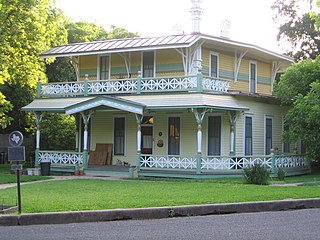
The Col. Monroe M. Shipe House is a historic two-story home in the Hyde Park historic district in Austin, Texas, United States. The building was completed by Monroe M. Shipe, founder of Hyde Park, in 1892. It uses an eclectic combination of styles, including a Stick style form, Queen Anne decorations, and a flat concrete roof.

The Hildreth–Flanagan–Heierman House is a historic home in the Hyde Park historic district in Austin, Texas. It is also a part of the Shadow Lawn Historic District, a subdivision of the Hyde Park neighborhood designated by Hyde Park founder Monroe M. Shipe.

The Frank M. and Annie G. Covert House is a historic home in the Hyde Park Historic District in Austin, Texas, United States. It is also a part of the Shadow Lawn Historic District, a subdivision within the Hyde Park neighborhood established by Hyde Park founder Monroe M. Shipe.
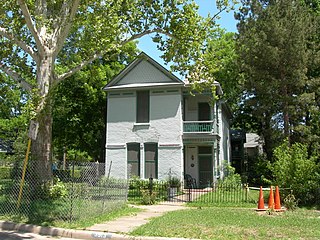
The Page–Gilbert House is a historic home in the Hyde Park Historic District in Austin, Texas, United States. It is also a part of the Shadow Lawn Historic District, a subdivision within the Hyde Park neighborhood established by Hyde Park founder Monroe M. Shipe.

The Smith–Marcuse–Lowry House is an historic home in the Hyde Park Historic District in Austin, Texas. It is also a part of the Shadow Lawn Historic District, a subdivision within the Hyde Park neighborhood established by Hyde Park founder Monroe M. Shipe.

The Oliphant–Walker House is a historic home in the Hyde Park Historic District in Austin, Texas. It is also a part of the Shadow Lawn Historic District, a subdivision within the Hyde Park neighborhood established by Hyde Park founder Monroe M. Shipe.

The Peter and Clotilde Shipe Mansbendel House is an historic home in the Hyde Park Historic District in Austin, Texas, United States. It is also a part of the Shadow Lawn Historic District, a subdivision within the Hyde Park neighborhood established by Hyde Park founder Monroe M. Shipe.

Cedarcroft is a distinctive residential neighborhood in the North district of Baltimore, bordered by Gittings, East Lake and Bellona Avenue avenues and York Road. According to Baltimore City's Commission for Historical and Architectural Preservation (CHAP), the houses in Cedarcroft are in the Dutch Colonial Revival, Federal Revival, Tudor Revival, Georgian Revival, Cape Cod Revival, Bungalow, and Italianate styles of architecture.

The Medbury's–Grove Lawn Subdivisions Historic District is a residential historic district located in Highland Park, Michigan. It runs along three east–west streets: Eason Street, Moss Street, and Puritan Street, from Hamilton Avenue on the west to Woodward Avenue on the east. The district was listed on the National Register of Historic Places in 1988.
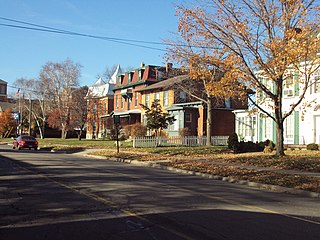
The East Elm–North Macomb Street Historic District is a residential historic district located in the city of Monroe in Monroe County, Michigan. The district was listed as a Michigan Historic Site and added to the National Register of Historic Places on May 6, 1982.
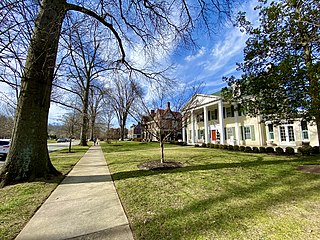
Ritter Park Historic District is a national historic district located at Huntington, Cabell County, West Virginia. The district encompasses 68 contributing buildings and 5 contributing structures, including the Ritter Park municipal park. The city purchased the park property in 1908. Dwellings in the district represent the finest styles in popular architecture from the years 1913 to 1940, including Colonial Revival, Bungalow/craftsman, and Tudor Revival. Notable buildings include the Ritter Park Apartments (1932), Weingartner House, Cammack House (1923), Marshall University President's House (1923), and Park Terrace Apartments.
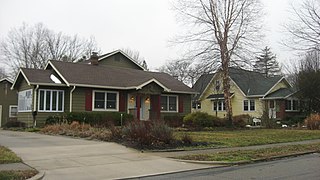
The Homecroft Historic District is a national historic district bounded roughly by Madison Avenue, Southview Drive, Orinoco Avenue, and Banta Road in Homecroft, Perry Township, Marion County, Indiana. It was listed on the National Register of Historic Places in 1996.

The Henry T. Oxnard Historic District is a 70-acre (28 ha) historic district that was listed on the National Register of Historic Places in 1999. Covering approximately F and G streets, between Palm and 5th streets, in the downtown core of Oxnard, California, the district includes 139 contributing buildings and includes homes mostly built before 1925. It includes Mission/Spanish Revival, Bungalow/craftsman, Colonial Revival, and other architecture. It includes five Prairie School and eight Tudor Revival homes.

Claremont High School Historic District is a national historic district located at Hickory, Catawba County, North Carolina. The district encompasses 172 contributing buildings and 3 contributing structures in a predominantly residential section of Hickory. Most of the dwellings date from the late 19th through mid-20th century and include notable examples of Queen Anne, Colonial Revival, Tudor Revival, and Bungalow / American Craftsman style architecture. The Claremont High School was completed in 1925, and is a three-story, "H"-shaped, Neoclassical style school. The school was rehabilitated in 1986 as an arts and science center. Other notable buildings include Maple Grove, Shuler-Harper House (1887), Harvey E. McComb House (1889), (former) Corinth Reformed Church Parsonage (1895), Shuford L. Whitener House, Judge W. B. Councill House (1902), George W. Hall House, Carolina Park, Josephine Lyerly House, John L. Riddle House (1918), Marshall R. Wagner House (1938), David M. McComb Jr. House (1939), Arthur H. Burgess House (1940), and R. L. Noblin House (1950).

Colonel Monroe Martin Shipe (1847–1925), also called M. M. Shipe, was an American real estate developer who developed Hyde Park, an early streetcar suburb in Austin, Texas. He also founded the Austin Electric Railway Company, a streetcar network that initially served Hyde Park but expanded to become the public transit network for the city of Austin and, eventually, the direct predecessor of Austin's current transit agency, Capital Metropolitan Transportation Authority.
